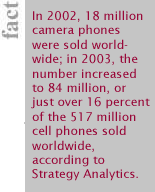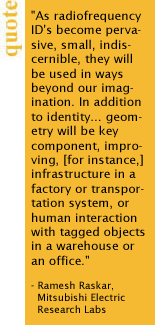|
| Projector
lights radio tags
|
|
|
Radio
tags promise a revolution in inventory control,
even as they threaten to diminish privacy. Add a
photosensor to each tag and they could also
enable augmented reality -- a melding of
everyday items and digital information. The key
to this low-cost system is a combination
projector and radio tag reader.
Full
story
| | |
Cell
phone melds video and data
Augmented reality, which overlays digital
information on real world objects, has been
largely limited to research prototypes and
military aircraft cockpits. A research team aims
to bring the technology to the masses with a
system that works on ordinary cell phones. The
trick is keeping the system lightweight enough for
cell phones' low-end cameras and computer chips.
Sound
system lets listeners move
Audio
engineers are able to capture and reproduce the
way sounds occur in specific places, creating the
illusion that a sound source is moving through the
listener's space. These effects usually require
you to hold your head in one position, however.
Headtracking headphones and accompanying software
offer a more liberating
experience.
Chips
measure electron spin
Several
of the wide variety of proposed quantum computer
architectures call for circuitry that is fairly
similar to today's computer chips, an advantage in
the race toward practical quantum computers. These
architectures, which use the orientations of
individual electrons to store information, have
received a boost with a pair of experiments that
show it is possible to electronically detect the
orientation of a single electron.
Briefs
Twisted
fiber filters light... Shifty
tiles bring walking to VR... Speck
trios make secret codes... Single
gold atoms altered... Pen
writes micro wires... Design
eases nano locomotion.
| | |
| | |





